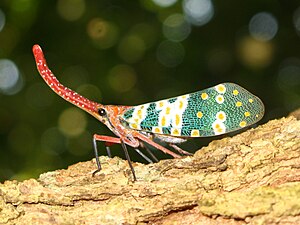Pyrops candelaria
| Pyrops candelaria | ||||||||||||
|---|---|---|---|---|---|---|---|---|---|---|---|---|

Pyrops candelaria in Laos |
||||||||||||
| Systematics | ||||||||||||
|
||||||||||||
| Scientific name | ||||||||||||
| Pyrops candelaria | ||||||||||||
| ( Linnaeus , 1758) |
Pyrops candelaria is a species of pointed head cicada (Fulgoromorpha) from the family of real lantern bearers (Fulgoridae) that occursin Asia. The specific epithet is based on the Latin word candela meaning 'candle'. In English usage, the species was originally referred to as Candle-Fly or Lantern-Fly (candle or lantern two-winged) and it was assumed that the trunk-like extension in front of the head shines like a candle at night. The kind but does not belong to the order of Diptera (Diptera), nor the trunk light.
features
Pyrops candelaria reaches a maximum height of 75 millimeters. Males are, on average, smaller than females. There is no sexual dimorphism between the sexes. The basic color of the forewings ( Tegmina ) is black-green and provided with several yellowish circular or elongated spots, some of which are bordered in white. A dense, very fine, light green network of veins stands out clearly. The upper side of the hind wings has a yolk yellow color. The outer edge shows a black-brown band that tapers towards the anal angle. The head has an elongated, red-colored, slightly curved, trunk-like extension in front of the eyes, which is covered with small white dots.
Occurrence and habitat
The species is widespread in east and south-east Asia. It prefers to colonize wooded areas.
Way of life and development
Pyrops candelaria is found mainly in the trunk area or in the treetops of deciduous tree species, where the animals feed on tree sap. Longan ( Dimocarpus ), mango ( Mangifera ) and lychee species ( Litchi ) are preferred . From March onwards, females lay their eggs here in balls of 50 to 100 pieces and wrap them in a foam-like, hardening mass for protection. The nymphs hatch after 26 days and are initially brownish in color. They inhabit the same habitat as the adults, but have a broader food spectrum. After an average of 109 days and five moults , the nymphs are fully grown.
Individual evidence
- ^ A b c d John Crampton Wilkinson Kershaw & George Willis Kirkaldy (1910): A Memoir on the Anatomy and Life-History of the Homopterous Insect Pyrops candelaria (or "Candle-fly"). , Zoological Yearbooks, Division for Systematics 29: 105-124. PDF
Web links
- eol.org - Encyclopedia of Life
- wildlifethailand - Wildlife Thailand
- Arthropods / Cambodia - Bugs of Cambodia
- pyrops-candelaria - The Lantern Bug
